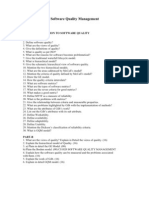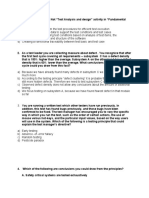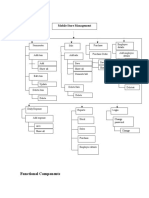0 ratings0% found this document useful (0 votes)
22 viewsQuestion Bank
Question Bank
Uploaded by
Siddharth Singhquestions
Copyright:
© All Rights Reserved
Available Formats
Download as PDF, TXT or read online from Scribd
Question Bank
Question Bank
Uploaded by
Siddharth Singh0 ratings0% found this document useful (0 votes)
22 views1 pagequestions
Copyright
© © All Rights Reserved
Available Formats
PDF, TXT or read online from Scribd
Share this document
Did you find this document useful?
Is this content inappropriate?
questions
Copyright:
© All Rights Reserved
Available Formats
Download as PDF, TXT or read online from Scribd
Download as pdf or txt
0 ratings0% found this document useful (0 votes)
22 views1 pageQuestion Bank
Question Bank
Uploaded by
Siddharth Singhquestions
Copyright:
© All Rights Reserved
Available Formats
Download as PDF, TXT or read online from Scribd
Download as pdf or txt
You are on page 1of 1
Unit – I:
1. How do you measure software Quality? Discuss correctness versus Reliability
pertaining to programs?
2. Discuss various types of metrics used in software testing and Relationship?
3. Define the following: i) Errors, ii) Faults, iii) Failure, iv) Bug, v) Defect vi) Incident
4. Discuss attributes associated with Software Quality?
5. What is Test Metric? List various Test Metrics? Explain any two?
6. Explain Static and Dynamic Software Quality Attributes?
7. Briefly explain the different types of test metrics.
8. Differentiate between correctness versus reliability.
9. What are input domain and program correctness?
10. Explain the test generation strategies.
11. Why is it difficult for tester to find all bugs in the system? Why might not be necessary
for the program to be completely free of defects before its delivered to customers?
12. Define Software quality. Distinguish between static quality attributes and dynamic
quality attributes. Briefly explain any one dynamic quality attributes.
13. Define the following: (i) Testability (ii) Verification
14. Explain the following: (i) Static Testing (ii) Model based testing and model checking
15. Explain how CFG assists the tester in analysis of program to understand the behavior
in terms of flow of control with examples.
16. Describe the following test classifiers: (i) Source of test generation (ii) Life cycle phase
(iii) Test Process Models
17. Explain variety of ways in which software testing can be integrated into the Software
development life cycle.
18. Define Generalized Pseudocode.
19. Explain the triangle problem, NextDate function and Commission problem.
20. Discuss the SATM system, Currency Converter, Saturn Windshield Wiper Controller,
Garage Door Opener.
21. Define Normal Boundary Value Testing. Explain Robust, Worst-Case Boundary Value
Testing and Special Value Testing.
22. Discuss with test cases of Triangle problem, NextDate function and Commission
Problem, boundary value testing.
23. Define Random Testing. Explain Guidelines for Boundary Value Testing.
24. Define Equivalence Classes. Explain Traditional and Improved Equivalence Class
Testing.
25. Discuss Strong, Weak Normal and Weak Robust Equivalence Class Testing.
26. Explain Equivalence Test Cases for the Triangle Problem, the NextDate function, the
Commission Problem. Explain Edge Testing.
27. Define Decision Tables. Explain Decision Table for Triangle Problem.
28. Discuss Decision Table concept with Test Cases for the Triangle Problem, the
NextDate Function, the Commission Problem.
29. Explain Cause-and-Effect Graphing with an example.
You might also like
- Real AZ 700 Study Guide For Microsoft Azure Network Engineer Associate 2021-8-30 PDFDocument12 pagesReal AZ 700 Study Guide For Microsoft Azure Network Engineer Associate 2021-8-30 PDFSeyed BillalganiNo ratings yet
- Professional Data Engineer QuestionsDocument4 pagesProfessional Data Engineer QuestionsChamakh AdelNo ratings yet
- ISTQB Certified Tester Foundation Level Practice Exam QuestionsFrom EverandISTQB Certified Tester Foundation Level Practice Exam QuestionsRating: 5 out of 5 stars5/5 (1)
- SQM 16 & 2marks With AnsDocument21 pagesSQM 16 & 2marks With AnsKalyan SundaramNo ratings yet
- Pragmatic Software Testing: Becoming an Effective and Efficient Test ProfessionalFrom EverandPragmatic Software Testing: Becoming an Effective and Efficient Test ProfessionalRating: 3 out of 5 stars3/5 (1)
- Automated Software Testing Interview Questions You'll Most Likely Be AskedFrom EverandAutomated Software Testing Interview Questions You'll Most Likely Be AskedNo ratings yet
- SQL Server Analysis Services TutorialDocument10 pagesSQL Server Analysis Services TutoriallearnwithvideotutorialsNo ratings yet
- ST Question Bank For Module-1 & 2 (CBCS)Document1 pageST Question Bank For Module-1 & 2 (CBCS)Aashish AcharyaNo ratings yet
- Question Bank - SQADocument6 pagesQuestion Bank - SQAsatyamshingade2No ratings yet
- Software Testing (STE 22514) UNIT TEST 1 Questions From MSBTE ExamsDocument2 pagesSoftware Testing (STE 22514) UNIT TEST 1 Questions From MSBTE ExamsKrishna Ahire0% (1)
- Software Testing Important QuestionsDocument2 pagesSoftware Testing Important QuestionsChaithra 0220No ratings yet
- Question Bank Software Testing: 11) State The Classification of White Box Testing. 12)Document2 pagesQuestion Bank Software Testing: 11) State The Classification of White Box Testing. 12)Chinmay DeshpandeNo ratings yet
- Software Testing Question BankDocument3 pagesSoftware Testing Question Bankkalpakpatil2004No ratings yet
- IMP Questions Software TestingDocument4 pagesIMP Questions Software TestingAkshat SinghNo ratings yet
- Software Testing & Quality AssuranceDocument3 pagesSoftware Testing & Quality Assurancek20pro9t4No ratings yet
- STE Question Bank For Unit Test #1Document2 pagesSTE Question Bank For Unit Test #1Nikita PatilNo ratings yet
- STQA IMP QB (E-Next - In)Document2 pagesSTQA IMP QB (E-Next - In)amaan shaikhNo ratings yet
- Question Bank - SQADocument6 pagesQuestion Bank - SQAfaradeeskhanNo ratings yet
- All Quebank On STDocument3 pagesAll Quebank On STaaryajadhav2243No ratings yet
- Chapter Wise Question BankDocument15 pagesChapter Wise Question BankManoj KavediaNo ratings yet
- ISTQB Question Paper With Answers # 14Document10 pagesISTQB Question Paper With Answers # 14Adriano BarbirNo ratings yet
- SE Que Lis 160701Document5 pagesSE Que Lis 160701has_meceNo ratings yet
- Important Questions UnitwiseDocument3 pagesImportant Questions UnitwiseLIVENo ratings yet
- ST Question BankDocument3 pagesST Question Banklapaw11259No ratings yet
- SQA Question BankDocument4 pagesSQA Question BankShabbeer BashaNo ratings yet
- Software Testing QBDocument3 pagesSoftware Testing QBShaikh EbadNo ratings yet
- STQA Imp QuesDocument3 pagesSTQA Imp QuesAnubhav SinghNo ratings yet
- Msit 32Document2 pagesMsit 32Seshadri KrishnaNo ratings yet
- Manual Testing FAQ SDocument16 pagesManual Testing FAQ Sprashanthm123No ratings yet
- Software Testing Module-1 Question BankDocument1 pageSoftware Testing Module-1 Question Bankajay aryaNo ratings yet
- Testing Interview Questions and AnswersDocument6 pagesTesting Interview Questions and AnswersThomas VaidyanNo ratings yet
- STQA IMP Bank For SPPU Students by MCA Scholar's GroupDocument3 pagesSTQA IMP Bank For SPPU Students by MCA Scholar's GroupIsha KaleNo ratings yet
- Software Testing and Quality Assurance - : Unit - 1 Two Marks QuestionsDocument5 pagesSoftware Testing and Quality Assurance - : Unit - 1 Two Marks QuestionsAanchal Padmavat100% (2)
- ISTQB Sample QuestionDocument6 pagesISTQB Sample QuestionDevi InsiNo ratings yet
- Cse-Viii-Software Testing (10CS842) - Question Paper PDFDocument5 pagesCse-Viii-Software Testing (10CS842) - Question Paper PDFRanjeetSinghNo ratings yet
- SQA Question BankDocument5 pagesSQA Question BankAbirami ManikandanNo ratings yet
- STE t1Document5 pagesSTE t1officialcar95No ratings yet
- Question Bank Software EngineerningDocument9 pagesQuestion Bank Software EngineerningZaheer AbbasNo ratings yet
- SQM Important QuestionsDocument4 pagesSQM Important QuestionsShankar Prakash GNo ratings yet
- Questions For InterviewDocument14 pagesQuestions For InterviewKhatia BeruashviliNo ratings yet
- STE Final Exam QuestionsDocument7 pagesSTE Final Exam QuestionsOmkar KotkarNo ratings yet
- SE Unit IV 2marksDocument7 pagesSE Unit IV 2marksPraveen RajNo ratings yet
- B4 3-R3Document28 pagesB4 3-R3api-3782519No ratings yet
- Interview QuestionsDocument15 pagesInterview QuestionsFizza NaeemNo ratings yet
- IstqbDocument242 pagesIstqbmahdiNo ratings yet
- The Likelihood of An Adverse Event and The Impact of The EventDocument65 pagesThe Likelihood of An Adverse Event and The Impact of The EventchitraNo ratings yet
- Ans Subjective-QuesDocument2 pagesAns Subjective-Quesapi-19934187No ratings yet
- ST (2 & 16 Mark Question Bank)Document23 pagesST (2 & 16 Mark Question Bank)AnithaNo ratings yet
- Kings: UNIT-1 Part (2 Marks)Document4 pagesKings: UNIT-1 Part (2 Marks)Sai SwethaNo ratings yet
- Software Testing Methodologies Assignment Questions UNIT-1Document5 pagesSoftware Testing Methodologies Assignment Questions UNIT-1forms. ch1203No ratings yet
- Software Testin-WPS OfficeDocument24 pagesSoftware Testin-WPS OfficeDinesh PatilNo ratings yet
- Complete Testing Interview QuestionsDocument22 pagesComplete Testing Interview QuestionssureshNo ratings yet
- Question PaperDocument9 pagesQuestion PaperAppu PrasadNo ratings yet
- MCQ Question Bank Short Answers STTDocument5 pagesMCQ Question Bank Short Answers STTAarya ShilimkarNo ratings yet
- ModelAnswer SET ADocument6 pagesModelAnswer SET AganeshkhedekkarNo ratings yet
- Đề-7 inDocument12 pagesĐề-7 inVũ KhánhNo ratings yet
- Cs1020 Software Quality Management Question Bank: Department of Computer Science and Engineering Question BankDocument6 pagesCs1020 Software Quality Management Question Bank: Department of Computer Science and Engineering Question BankVignesh KumarNo ratings yet
- Software TestingDocument6 pagesSoftware Testingगोपाल शर्माNo ratings yet
- ISTQB Sample Question Paper Dump #14Document7 pagesISTQB Sample Question Paper Dump #14SreejayabalajeeNo ratings yet
- CISSP - Certified Information Systems Security Professional Exam Preparation Study GuideFrom EverandCISSP - Certified Information Systems Security Professional Exam Preparation Study GuideRating: 5 out of 5 stars5/5 (1)
- 06-Data-Integration Quality ProfilingDocument39 pages06-Data-Integration Quality ProfilingSiddharth SinghNo ratings yet
- 05-BI Framework and ComponentsDocument22 pages05-BI Framework and ComponentsSiddharth SinghNo ratings yet
- 02-Types of Digital DataDocument33 pages02-Types of Digital DataSiddharth SinghNo ratings yet
- 01-Business View of ITDocument10 pages01-Business View of ITSiddharth SinghNo ratings yet
- Petrel 2017 Release NotesDocument18 pagesPetrel 2017 Release Notesoscar100% (1)
- CEH-Certified Ethical Hacker: Required PrerequisitesDocument3 pagesCEH-Certified Ethical Hacker: Required PrerequisitessenejaniNo ratings yet
- Transaction Management SQL Isolation Level: 1. Read CommittedDocument2 pagesTransaction Management SQL Isolation Level: 1. Read CommittedAhmed SartajNo ratings yet
- Localizing Portlets With Ibm Websphere Portlet FactoryDocument10 pagesLocalizing Portlets With Ibm Websphere Portlet Factoryaakash_kushwah100% (2)
- 4-30106C2P LP51021 CRYPT2Pay CRYPT2Protect Security Policy V2.2-1554489077.52112-DN PDFDocument87 pages4-30106C2P LP51021 CRYPT2Pay CRYPT2Protect Security Policy V2.2-1554489077.52112-DN PDFRifat Hasif PutrafebrianNo ratings yet
- Lab 2.8.3: Troubleshooting Static Routes Topology Diagram: (Instructor Version)Document11 pagesLab 2.8.3: Troubleshooting Static Routes Topology Diagram: (Instructor Version)leoredf1No ratings yet
- MSBI Installation GuideDocument25 pagesMSBI Installation GuideAmit SharmaNo ratings yet
- Active Recon Cheat SheetDocument3 pagesActive Recon Cheat Sheetlbb1987No ratings yet
- Week6 Iot Big DataDocument21 pagesWeek6 Iot Big DataHector TiboNo ratings yet
- Veritas Volume Manager VM DaemonsDocument10 pagesVeritas Volume Manager VM DaemonsSatishkumar KundetiNo ratings yet
- Java Quiz 1Document3 pagesJava Quiz 1V100% (2)
- TorrcDocument3 pagesTorrcAndrés FernandezNo ratings yet
- Activity 2Document2 pagesActivity 2Zin DelNo ratings yet
- Functional Components: Mobile Store ManagementDocument7 pagesFunctional Components: Mobile Store ManagementKingSlayer GamingNo ratings yet
- Laravel and Wordpress On The Same Domain (Laravel in Subfolder)Document3 pagesLaravel and Wordpress On The Same Domain (Laravel in Subfolder)M-kamalNo ratings yet
- Getting Started GuideDocument62 pagesGetting Started GuidevladimirNo ratings yet
- Play! Framework Cheat SheetDocument5 pagesPlay! Framework Cheat SheetLab BhattacharjeeNo ratings yet
- Library Management System Project ReportDocument6 pagesLibrary Management System Project Reportyeglwork asefaNo ratings yet
- Data Wrangling, Also Known As Data Munging, Is An Iterative Process That Involves DataDocument9 pagesData Wrangling, Also Known As Data Munging, Is An Iterative Process That Involves DataAlexandrina LikovaNo ratings yet
- Cloud Computing SylabusDocument2 pagesCloud Computing SylabusKabul KurniawanNo ratings yet
- Last Mile - Mobile App For LogisticsDocument12 pagesLast Mile - Mobile App For Logisticstechbyte101No ratings yet
- Software Engineer Job DescriptionDocument5 pagesSoftware Engineer Job Descriptiondavid archuletakNo ratings yet
- Course 20339-1A - Planning and Administering SharePoint 2016Document8 pagesCourse 20339-1A - Planning and Administering SharePoint 2016Ashish Kolambkar0% (1)
- RG2904 PI Configuration XML ArchivingDocument22 pagesRG2904 PI Configuration XML Archivinghunter.correaNo ratings yet
- Ch7 EcomAllDocument32 pagesCh7 EcomAllGagandeep SinghNo ratings yet
- Software Engineering 10Document6 pagesSoftware Engineering 10Veena WagleNo ratings yet
- What Is The Difference Between Procedural and Object Oriented Programming ?Document7 pagesWhat Is The Difference Between Procedural and Object Oriented Programming ?kiranscribd6No ratings yet





























































































